.15.10.2013
Solar eclipse fans donate spectacles for Africa's young spectators
.
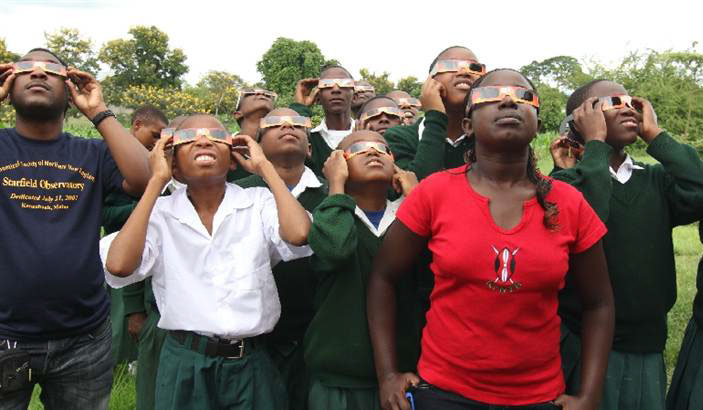
African schoolchildren use special viewing glasses to observe the sun safely.
.
his year's only total solar eclipse, on Nov. 3, will be a beautiful moment for eclipse-chasers — and a teachable moment for tens of thousands of schoolchildren in Africa. To make the most of that moment, Astronomers Without Borders is gathering up donations to send those kids the glasses they need to watch the eclipse's progress safely.
"This is a natural laboratory for science," the group's founder and president, Mike Simmons, told NBC News. "It's not something that anybody needs to pay for. It's brought to millions, courtesy of nature."
So far, more than 8,700 eclipse-viewing glasses have been donated, but Astronomers Without Borders has gotten requests for more than 41,000. There's not all that much time to try to fill the gap, but Simmons says it's not too late to donate by credit card or PayPal. One dollar buys one pair of glasses.
Next month's eclipse is what's known as a hybrid, which is a rarity in astronomy. Only 5 percent of all solar eclipses are hybrids. Because of the moon's changing position, this hybrid starts out as a "ring of fire" annular eclipse over the Atlantic, and turns into a total eclipse by the time the moon's shadow reaches Gabon on Africa's west coast.
Totality will be visible only from a narrow track of land, stretching from Gabon in the west to Kenya and Ethiopia in the east. But most of Africa will see the partial phase of the eclipse, weather permitting. And that's where the glasses come in handy. Although the total phase of a solar eclipse can be viewed safely with the naked eye, no one should ever look at a partial solar eclipse with unprotected eyes, even if only a sliver of the sun is showing.
.
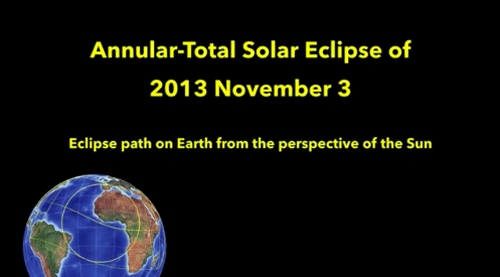
.
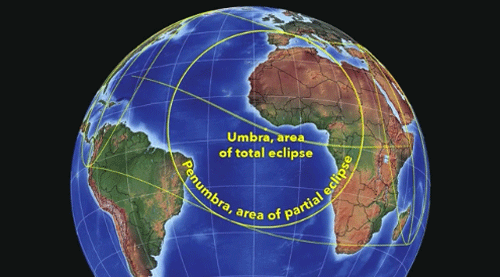
.
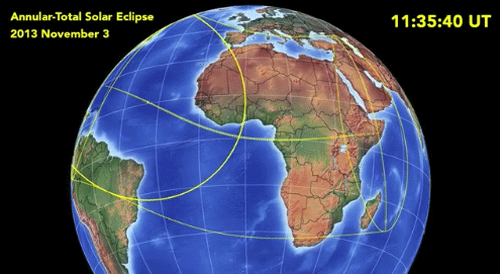
.
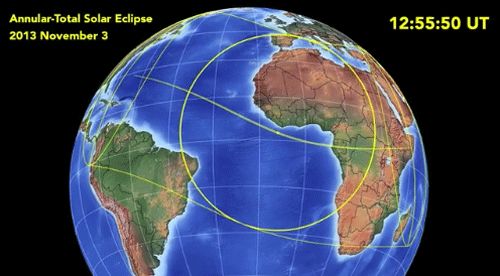
.
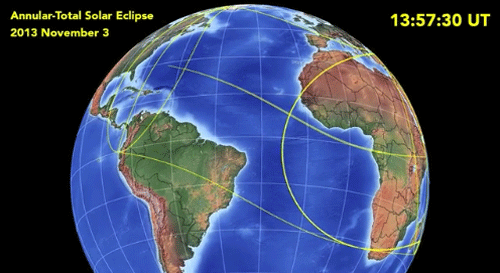
Simmons hopes kids across Africa will get that message, and get the right kind of eyewear as well. "There's always a lot of education to do with eclipses," he said. "Even with the last couple of eclipses in Australia, there was a lot of misinformation."
Africa poses special challenges. "These are areas where science education is very difficult, simply because of the lack of resources," Simmons said.
To make sure the glasses get into the right hands, Astronomers Without Borders is partnering with the International Astronomical Union's Office of Astronomy for Development, which is based in South Africa. The IAU has agreed to distribute the glasses as part of its 10-year strategic plan to promote science education in the developing world.
Some of the folks in the Astronomers Without Borders network, plus an allied group called Telescopes to Tanzania, are facilitating transport. "We're sending them with eclipse-chasers who are going to countries where the eclipse will be visible," Simmons said. "Some will go as late as the 28th."
Simmons' big problem is that he's getting so many orders for the glasses from African schools that he can't fill them all. "We could easily do 75,000," he told NBC News. "I don't think that's going to happen due to the short amount of time, just logistically."
But every pair of safety specs helps. Stay tuned for updates about the hybrid eclipse and how to see it online as the big day approaches.
.
Quelle: NBC
.
The animation shown in the diagram to the right illustrates the motion of the shadow of the Moon at five minute intervals. This animation runs in a continuous loop.
This graphic, provided by Dr. Andrew Sinclair, shows the grey penumbral shadow where the eclipse will be seen as a partial one and the much smaller black umbral shadow where the eclipse will be seen as an annular or total one. The UT time is shown in the upper right-hand corner of the diagram and the central line duration of the eclipse can be seen in the lower right-hand corner.
.
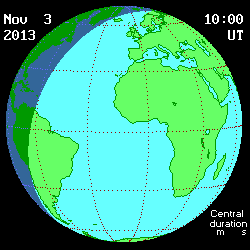
.
Quelle: HM Nautical Almanac Office
.
Update: 30.10.2013
.
Partielle Sonnenfinsternis am kanarischen Himmel
.
Am kommenden Sonntag, den 3. November wird sich der Mond vor die Sonne schieben. Das Himmelsschauspiel wird von den Kanarischen Inseln aus als partielle Sonnenfinsternis zu sehen sein.
Kanarische Inseln - Sichtbar wird die Finsternis zuerst vor der amerikanischen Ostküste südlich der Bermuda-Inseln als ringförmige Verdunkelung und überquert anschließend den Atlantik. Nach wenigen hundert Kilometern, wenn der Kernschatten die Erde trifft, wird sie total. Dann zieht sie etwa 500 Kilometer südlich der Kapverden vorbei und erreicht vor der Küste Liberias ihre höchste Bedeckungsdauer. Eine Minute und 40 Sekunden lang ist die schwarze Sonne dort zu sehen. Dann überquert sie Afrika in Äquatornähe und endet im Grenzgebiet zwischen Somalia und Äthiopien.
Auf den Kanarischen Inseln schiebt sich ab 10:45 Uhr der Mond vor die Sonne und wird sie zum Höhepunkt um 12:09 Uhr zu 31 Prozent verdecken. Bis 13:29 Uhr lokaler Zeit wird das Himmelsschauspiel zu beobachten sein. Wichtig: Adäquaten Augenschutz nicht vergessen!
Quelle: Wochenblatt-Kanarische Inseln
.
All roads lead to Uganda for solar eclipse viewing
Uganda is set to enjoy its time in the sun, literally, as thousands of tourists are expected in the East African country to experience a rare phenomenon, the solar eclipse.
The event is set to occur on 3 November, 2013.
Meteorologists say the vantage points will be in Pakwach town, situated in Uganda's West Nile region.
A solar eclipse last occurred in Uganda on 16 March, 1466 and the next one will only be on 3 June, 2114.
The country's Tourism minister, Maria Mutagamba has confirmed that more than 10,000 foreigner tourists have so far booked to visit the country for a clear view of the once in a lifetime event.
"We have been informed that best viewing site in the whole world will be West Nile region especially in Pakwach district," Mutagamba said.
"But even in other areas of the country, people will be able to experience the eclipse.
Already over 10,000 foreigners have confirmed that they are coming, but we expect a bigger number of foreigners.'
'
At least 30,000 foreign visitors are expected in West Nile.
A solar eclipse is an extraordinary geographical phenomenon of the movement, when the moon comes in between the earth and the sun, creating a temporary darkness.
.
Quelle: The Africa Report
.
Update: 31.10.2013
.
.
Eastern U.S. to See Partial Solar Eclipse Nov. 3
WILLIAMSTOWN, Mass., For people in the eastern United States, the sun will rise half covered by the moon on Sunday morning, November 3, and the partial eclipse will last about 3/4 of an hour. Jay Pasachoff, Field Memorial Professor of Astronomy at Williams College and chair of the International Astronomical Union’s Working Group on Eclipses, advises that people able to see very low on the eastern horizon and having suitable filters in hand would enjoy the event.
A total solar eclipse will sweep across Africa about two hours later on that Sunday, when it will be afternoon, six hours later, in west Africa. After starting in the Atlantic, the shadow of the moon will reach Gabon, where Pasachoff and colleagues will observe totality, with the support of a research grant from the Committee for Research and Exploration of the National Geographic Society.
.
The eclipse will then continue across Africa through the Congos until it passes through northern Uganda, and northern Kenya, ending in southern Ethiopia and Somalia. The path of totality, when the bright everyday surface of the sun is entirely covered by the moon, will cross the middle of Gabon. Totality, weather permitting, in the middle of Gabon will be about 1 minute long, compared with only about 10 seconds long in northern Kenya.
Only partial phases of the eclipse will be visible in the U.S., in southern Europe (Spain, lower Italy, and Greece) and throughout the rest of Gabon, and through almost all of Africa (except for the southernmost tip).
Since the Sun’s everyday surface is too bright to look at safely, to safely look at the partial phases people will have to make a simple “pinhole camera” (merely a 3 mm or so hole in a piece of paper that is used to project the sun onto another piece of paper, and then you look at that second paper with the sun behind you) or else get special filters—almost a million times darker than ordinary sunglasses–made to be safe for observing the sun.
.
In the United States, the partial eclipse will be visible at sunrise, 6:30 a.m. on that day in the eastern standard timezone. (Earlier that morning, daylight saving time will end at 2 a.m.) The sun’s diameter will be over 50 percent covered by the silhouette of the moon at sunrise in Boston and New York, and 47 percent covered in Washington, D.C., and Miami. By about 45 minutes later, when the eclipse is about 8 degrees high in the sky (about four fingers high at the end of your outstretched arm), only a tiny bit of the sun would be covered by the moon’s silhouette. So viewers will really want to look between sunrise and about a half hour later, when the sun is only about two fingers high on the east-southeast horizon. And viewers will need a true horizon level with them, not encumbered by even low, distant buildings, hills, or mountains.
.
Quelle: Williams College
.
Update: 1.11.2013
.
'Dramatic' Partial Solar Eclipse Could Wow US East Coast Sunday
An amazing partial solar eclipse will be visible across much of Eastern Seaboard as the sun rises on Sunday (Nov. 3), but only if Mother Nature allows, skywatching experts say.
The celestial event is known as a hybrid solar eclipse, a rare event in which the moon blocks most of the sun for some regions on Earth, but covers the star entirely from others. Along the east coast of North America, only a partial solar eclipse will be visible, weather permitting.
"It'll be a weird and dramatic spectacle, if your east horizon is clear," Robert Naeye, editor in chief of Sky & Telescope magazine, said in a statement
Quelle: SPACE
.
Update: 2.11.2013
.
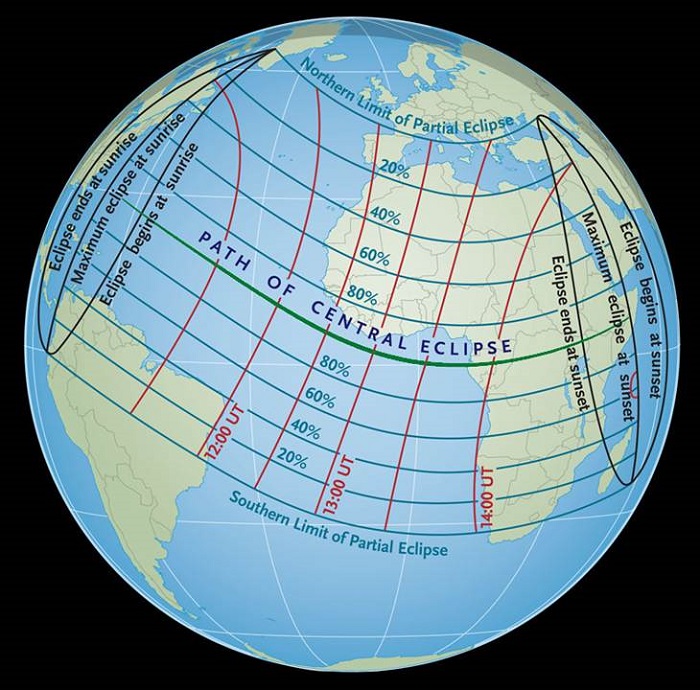
The partial phase of Sunday's solar eclipse can be seen over a wide swath of the world, but the annular-total phase is visible only along a narrow track. The eclipse begins as a "ring of fire" annular event, but turns total by the time the moon's shadow reaches the African coast.
.
Quelle: NBC
.
Upadate: 3.11.2013
.
Erste Aufnahmen von SoFi über Afrika
,

.

Taken by Nicholas Sperling on November 3, 2013 @ West Orange, New Jersey, USA
.
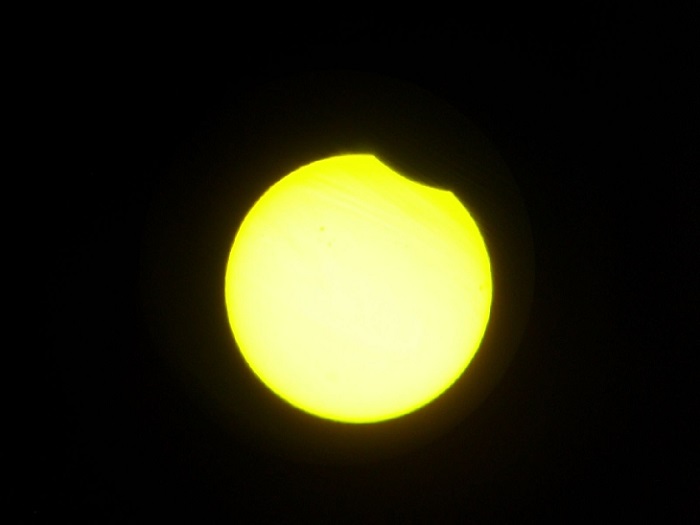
Taken by Valentina Torre on November 3, 2013 @ Messina, Sicily, Italy
.
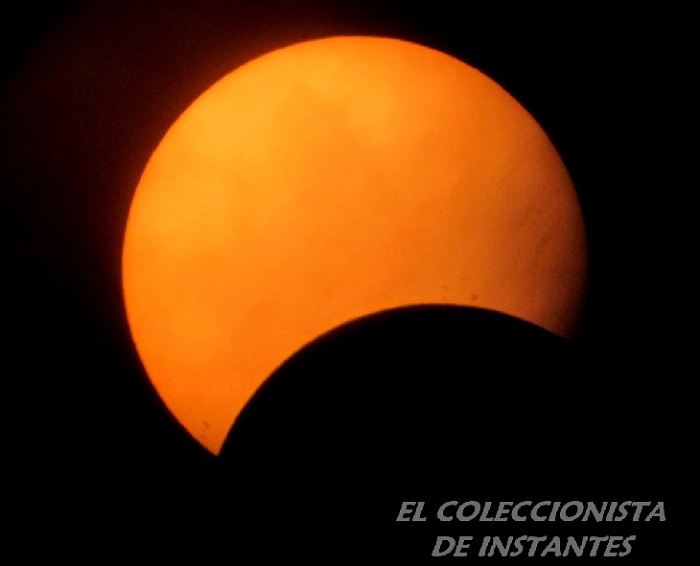
Taken by Juan Ramon Rodriguez Sosa on November 3, 2013 @ Las Palmas de Gran Canaria
.
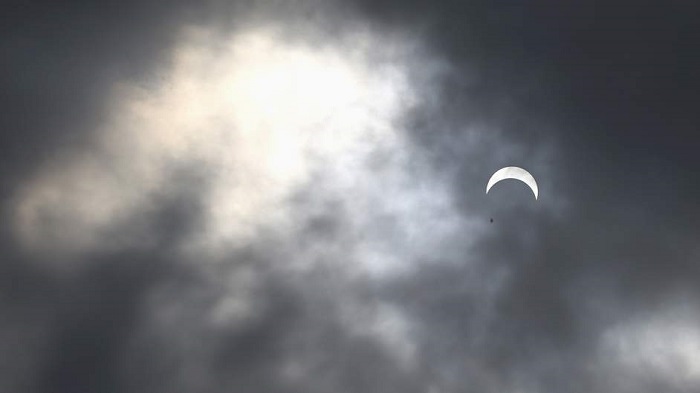
Skywatchers in Lagos, Nigeria, had a cloudy view of the solar eclipse
.
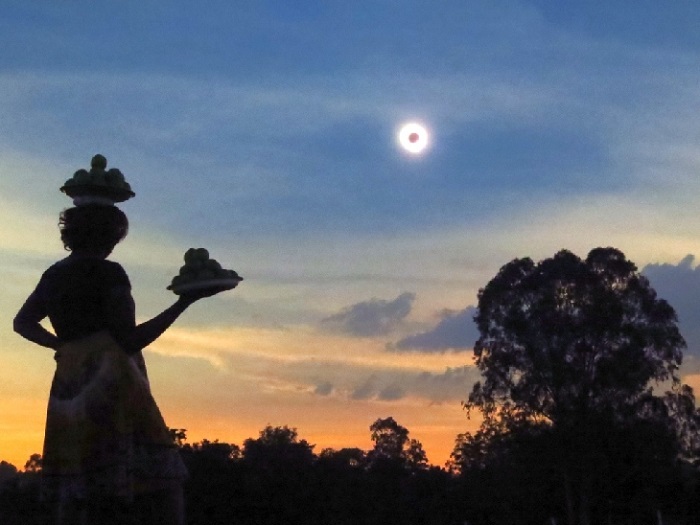
Taken by Janne Pyykkö on November 3, 2013 @ Gulu, Uganda
.
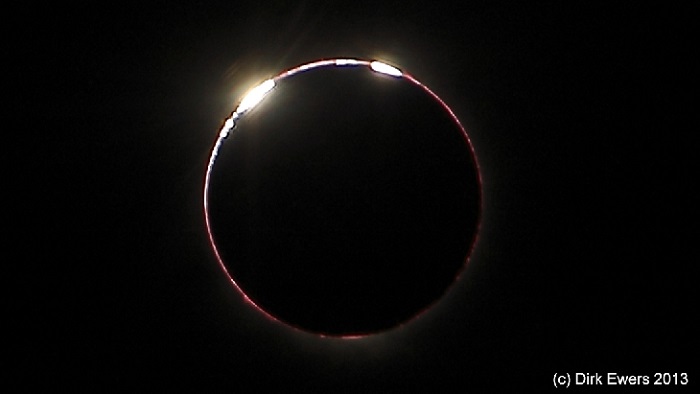
Taken by Dirk Ewers on November 3, 2013 @ Atlantic Ocean, 1200km southeast of Bermuda, onboard a private Jet (shared by a Group of 12 People)
.
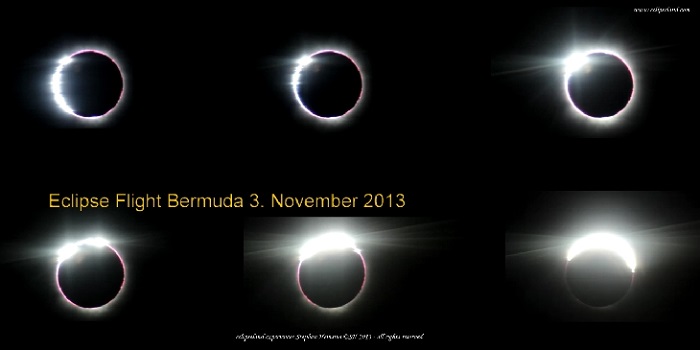
Solar Eclipse From Airplane @43000ft
Taken by Stephan Heinsius on November 3, 2013 @ Atlantic Ocean
Taken by Stephan Heinsius on November 3, 2013 @ Atlantic Ocean
.
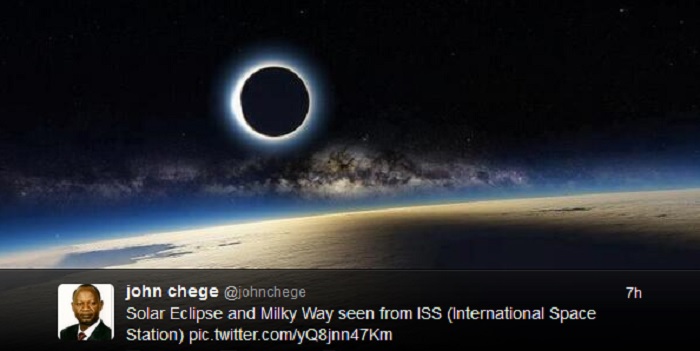
.
Update: 4.11.2013
.
Rückblick auf Afrika-SoFi
.
Thousands view total solar eclipse in Pakwach
PRESIDENT Yoweri Museveni yesterday seized the viewing of the solar eclipse to market the tourism industry and called for the preservation and conservation of wildlife.
Addressing hundreds of ecstatic eclipse viewers (both local and foreign) who thronged Owiny Primary School in Pakwach town, Nebbi district, Museveni also warned of the social dangers that can be imported into the country through tourism.
Highlighting Uganda’s endless endowments as he appealed particularly to foreign tourists, Museveni assured the world of peace and stability in the country
He said peace is a prerequisite for tourism and invited the world to make Uganda their favourite tourism destination.
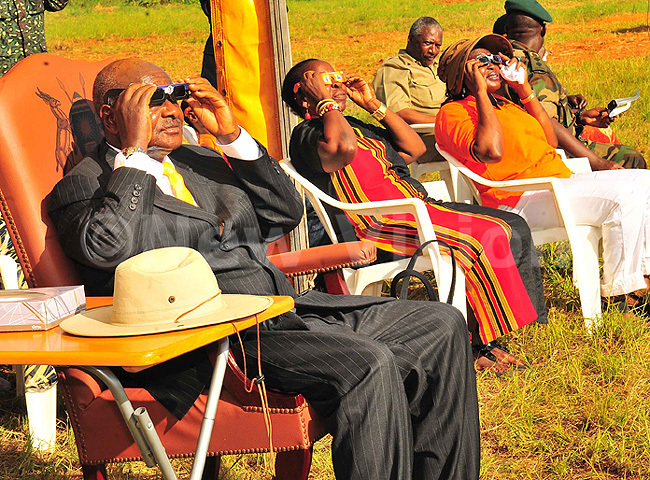
WHERE?: President Yoweri Museveni; Minister of tourism, Maria Mutagamba; Fisheries state minister, Ruth Nankabirwa.
.
At the function attended by ministers and members of the diplomatic corps, Museveni said Uganda was endowed with unequalled natural and cultural flora and fauna.
But he was sensitive to the reason that had gathered the multitude of people at the schoolthe best viewing place, keeping his speech short.
“I am looking at my watch because I do not want to interfere with your viewing of the eclipse,” he said.
After his speech, Museveni retreated to the presidential tent to wait for the hybrid solar eclipse. With the aid of viewing filters, he occasionally left his seat to look at the sky and follow the slow and gradual process that began at 4:15pm.
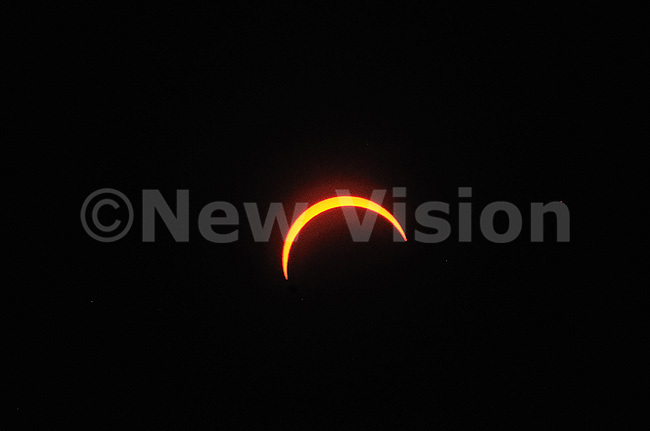
CRESCENT-LIKE: The arched yellow slit of the sun representing moments before the total eclipse could occur.
.
At about 5:11pm the sun, which had hitherto been covered by clouds, reappeared with three quarters of it covered by the moon.
Viewers cheered as others jostled for a picture moment. At 5:21pm, the moon covered the sun totally, plunging the place into darkness. Viewers went wild with the experience that last happened in 1466 and is expected to reoccur in 2114.
Museveni said there were deliberate efforts by the Government to revamp the tourism industry which contributes $1.5m and the efforts were beginning to bear fruit.
“Uganda is regaining its position as a top tourism destination as it was in the 1950s and 60’s,” he said and appealed for the preservation of wildlife.
.
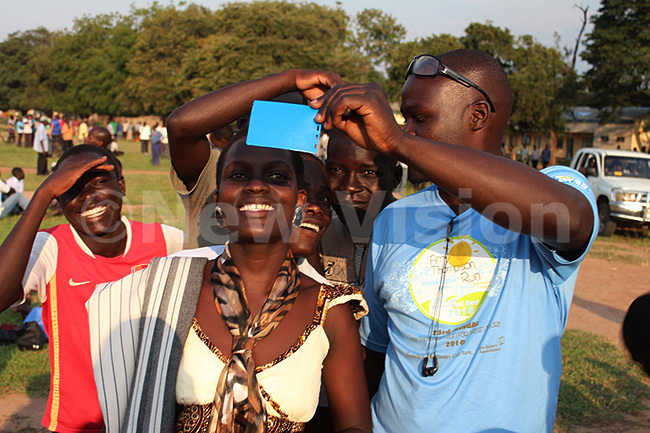
BLUISH GLIMPSE: At Soroti Sports grounds in Soroti town, a strategic point to chance at the eclipse, locals made the best out of the moment.
.
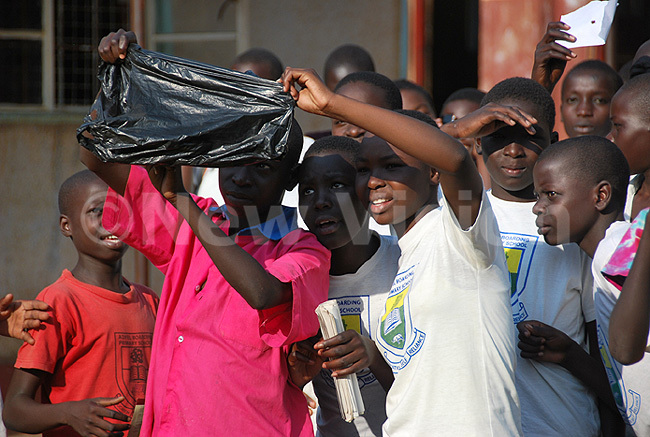
BLACK PAPER: School children in Lira made it a point not to be left out of this rare moment.
.
Museveni added that some other people want to invade national parks to grow malakwang, a local vegetable, which is not acceptable.
Moments earlier, he had laid the foundation for the information and tourism centre in Pakwach town council and later commissioned the eclipse monument at the school.
Given the rigorous searches that people were subjected to, the president apologised to foreign viewers for the heightened security measures, saying it was meant to combat terrorism. “Terrorists can use the cover tourism to cause harm to the country,” he said.
The President warned of a host of social dangers and vices such as drug trafficking, child labour and prostitution that can come along with tourism. “We must have mechanisms to guard against these vices,” he said.
Uganda, Museveni said, was gifted with unique attributes, saying it is the only place on the Equator, with sunshine and permanent snow.
“That combination is not easy to get in the world. We have sunshine all day around and a lot of rainfall, greenery and permanent snow.
“My appreciation goes to the foreign guests for coming to view the eclipse. I invite you to explore other parts of northern Uganda and other parts of Uganda to experience our legendary hospitality, cultural richness and the natural beauty of the pearl of Africa,” the President said
Museveni added that Uganda is one out of the three places in the world right on the equator with a high altitude.
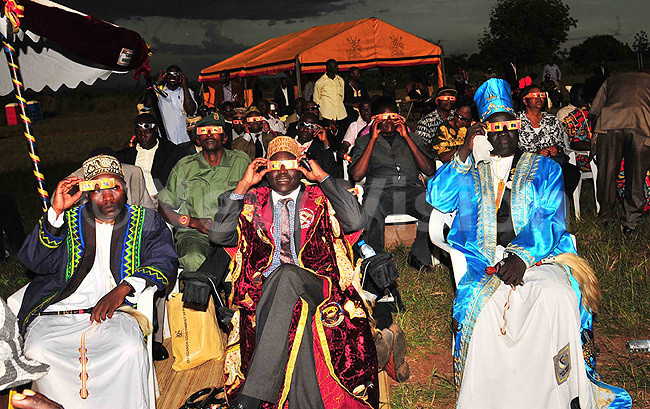
DUSK TOO EARLY: The Aru King views the eclipse with other local leaders at Owiny Primary School.
.
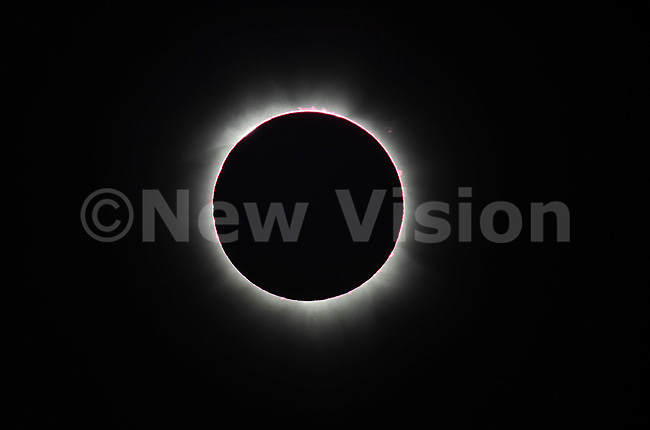
SOLAR RING: The moment every one had waited for. Seconds later, it was ring was all gone and an eerie blackness filled the skies for about 50 seconds amid excitement and cheers before the sun re-appeared.
.
Quelle: New Vision
.
Tourists throng northern Kenya to witness rare solar eclipse
.
Kenya: Kenyans Sunday witnessed a rare solar eclipse which allowed a view of the sun that was totally or partially blocked by the moon.
The eclipse was first visible in the southern United States, before sweeping east across the Atlantic Ocean and the African continent.
The US space agency, Nasa, said the greatest total eclipse occurred over the Atlantic Ocean.
One of the best views was in northern Kenya, where tour companies organised trips to view a total blackout.
Local myths in northern Kenya attribute the event to the moon eating the sun.
Partial views were available in eastern North America and southern Europe.
This solar eclipse was a rare occurrence in that it was “hybrid” - switching between an annular and total eclipse.
In a total eclipse, the moon completely covers the sun, while an annular eclipse occurs when the moon is at its farthest from the Earth and does not block out the sun completely, leaving a halo of sunlight still visible around the Moon.
The eclipse event began about 1,000km (620 miles) east of Jacksonville, Florida with an annular eclipse visible for four seconds at sunrise.
Atlantic Ocean
As the moon’s shadow raced east the eclipse switched from annular to total along a narrow corridor.
The greatest total eclipse occurred in the Atlantic Ocean, approximately 330km south-west of Liberia, and lasted for more than one minute.
The eclipse continued across Africa through the Congos until it passed through northern Uganda and northern Kenya, ending in southern Ethiopia and Somalia.
On either side, a partial eclipse was seen within a much broader path including eastern North America, northern South America, southern Europe, the Middle East and Africa.
Experts warned that no-one should attempt to view the sun with the naked eye.
A safe view of eclipses can be obtained by using special welder’s glasses or a pinhole camera.

Partial solar eclipse is seen from nothern Kenya.
Quelle: STANDARD
.
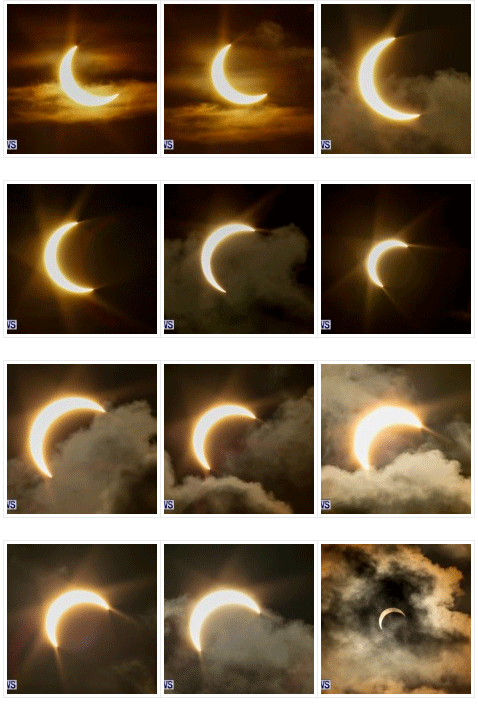
Quelle: Bermuda News
6797 Views
